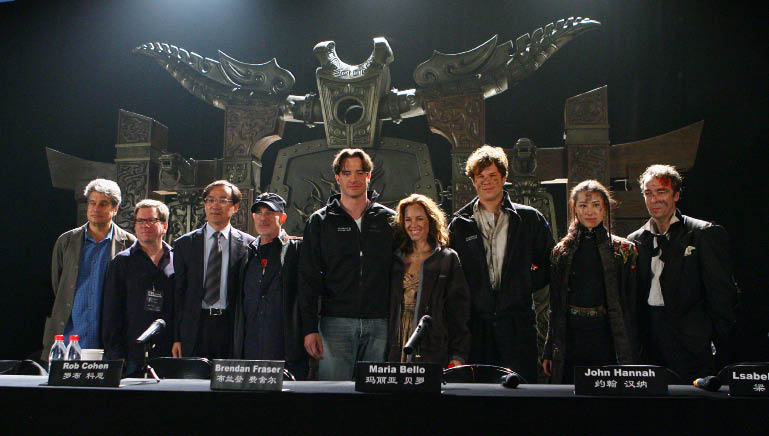Beyond Kung Fu
China’s Film Industry Enhances Ties with the International Market
By LIU TONG
SINCE the beginning of the Chinese policy of reform and opening-up, and especially since the 1990s, China’s film industry has seen increasingly close exchanges with the wider filmmaking world.
These days more screens are showing a greater variety of films from around the world than ever before. Many Chinese filmmakers enjoy creative, collaborative relationships with their foreign counterparts and have co-produced many films. Their cooperation is a boon for Chinese cinema and, thanks to the communicative power of film, goes some way toward furthering the world’s knowledge of Chinese society and culture.
 |
| The production crew of The Mummy: Tomb of the Dragon Emperor at a press conference in Shanghai in 2007. |
Promoting Understanding through Collaboration
Chinese films were first seen by world audiences at international film festivals and exhibitions. In 1935, Song of the Fishermen became the first Chinese movie to be shown abroad, and won a prize at the Moscow International Film Festival. In the following decades and after the birth of New China, generations of Chinese filmmakers shared an ambition to have Chinese movies screened globally. They hoped audiences would see China through film and learn more about the country, which in those years was somewhat of an unknown entity in the West.
In 1982, China held a film exhibition in Italy, during which 135 Chinese films were shown. It was a success, and since then an increasing number of such film exhibitions, sponsored by either government or non-governmental organizations, have been held. They offer a window through which the world can learn about China. Attendees at such exhibitions, however, tend to be specialists such as filmmakers and researchers. To allow Chinese films to reach lay viewers, Chinese films needed to crack the mainstream film festival circuit.
In 1988, Red Sorghum, directed by Zhang Yimou, won the Golden Bear Award at the Berlin International Film Festival. Over the next decade, many Chinese avant-garde films would go on to receive international awards. Their success greatly boosted Chinese films’ reputation among foreign audiences.
In 1996, the China Film Group Corporation launched the first “Beijing Screenings,” where film distributors from around the world were invited to watch a total of 18 Chinese films in Beijing. The “Beijing Screenings” Film Exhibition served as a platform to connect filmmakers and film distributors. Through direct communication and cooperation, a number of good Chinese movies reached movie theaters the world over.
In 2011 Beijing organized an annual international film festival to further promote cooperation. It included “Beijing Screenings.” The second Beijing International Film Festival, held in 2012, saw over 2,000 participants from 600-odd film production companies, who signed distribution deals worth a total RMB 5.273 billion. The 2012 film festival also saw the launch of China’s film investment program. Features from 12 countries and regions, including the U.S., Canada, the U.K., Australia, South Africa and South Korea, competed for the generous funding opportunity. Twenty movies made it to the final selection round.
Getting to Know Each Other
In the 1920s and 1930s, foreign films, especially those from Hollywood, drew large audiences in Chinese cities such as Shanghai. Take the year 1933 as an example: 433 foreign movies were introduced to China, 353 of which were American. A new Hollywood film was released in the country almost every day.
Many Chinese filmmakers at the time learned from Western cinematography by watching Hollywood movies. They would take notes while watching, using a flashlight when the cinema lights dimmed.
During the period after the People’s Republic of China was founded and before reform and opening-up, China never stopped showing foreign films, the majority of which were from socialist countries. At that time domestic film distributors would often obtain the distribution rights for Soviet hits for as much as US $ 20,000 per film.
Hollywood film industry representatives launched distribution negotiations with China in 1979. In 1994, China finally enacted a policy to implement a revenue-sharing mechanism for imported American films. That year, The Fugitive, the first Hollywood blockbuster imported under the mechanism, was a runaway hit in China. It joined nine other Hollywood films shown in 1994 on the Chinese big screen.

